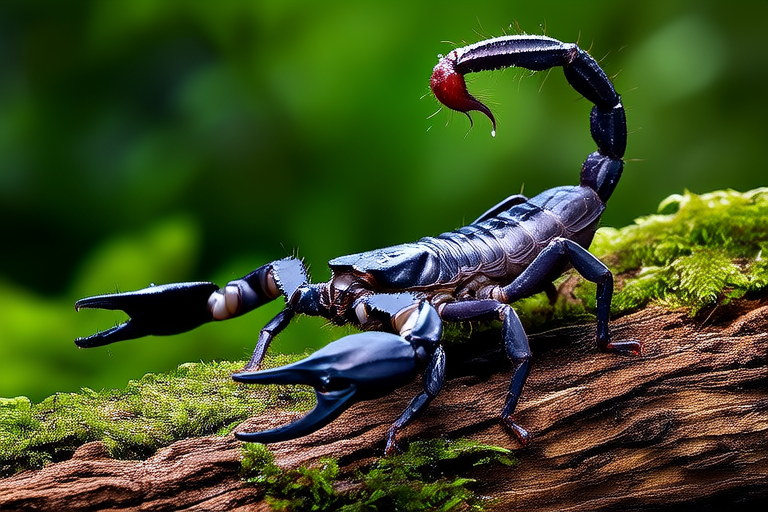Pet Owners Beware: Discover the Lesser-Known Facts About the Heterometrus Spinifer
Introduction
As a pet owner, it’s essential to be aware of potential threats lurking in your surroundings, especially when it comes to exotic creatures that may not be as well-known as others. One such creature is the Heterometrus spinifer, a species of scorpion native to Southeast Asia. This article aims to provide you with valuable information about this lesser-known species, including its habitat, diet, behavior, potential dangers to pets, and unique characteristics. By understanding these aspects, you can take necessary precautions to protect your beloved pets.
Habitat and Distribution
The Heterometrus spinifer is primarily found in tropical and subtropical regions of Southeast Asia, including countries like Thailand, Malaysia, Indonesia, and Singapore. These scorpions prefer humid environments and can often be found in dense forests, caves, and under rocks or logs. They thrive in areas with high humidity levels, making them less likely to venture into drier urban settings. However, human activities such as deforestation and urbanization have driven some of these scorpions closer to residential areas, increasing the risk of encounters with pets.
Diet and Feeding Habits
The Heterometrus spinifer is a carnivorous predator, feeding mainly on insects, spiders, and other small invertebrates. Their diet consists of prey items they can capture using their powerful pincers and venomous stinger. While these scorpions are generally not aggressive towards larger animals, they will defend themselves if threatened. It is crucial to understand their feeding habits to prevent accidental interactions with pets.
Behavior and Unique Characteristics
One of the most striking features of the Heterometrus spinifer is its size. Adults can reach lengths of up to 12 centimeters, making them one of the largest scorpion species in Southeast Asia. Their bodies are typically dark brown or black, with distinctive spines along their tail, which gives them their common name, the “spiny-tailed scorpion.” These spines serve as a defensive mechanism, deterring predators and making them appear more formidable.
In addition to their physical attributes, these scorpions exhibit unique behaviors that set them apart from other species. For instance, they are nocturnal creatures, meaning they are most active during the night. During the day, they seek shelter in dark, cool places, making them harder to spot. However, their preference for nighttime activity increases the likelihood of encounters with pets, especially those that are active during the evening or early morning hours.
Potential Dangers to Pets
While the venom of the Heterometrus spinifer is not considered lethal to humans, it can still pose significant risks to smaller animals, particularly pets. The venom contains neurotoxins that can cause severe pain, swelling, and muscle spasms in affected areas. In extreme cases, envenomation can lead to respiratory distress or even death in small animals, depending on the amount of venom injected and the size of the animal.
It is important to note that pets, especially curious dogs and cats, may accidentally disturb a Heterometrus spinifer while exploring their environment. Curiosity can lead to painful stings, and the resulting discomfort could make your pet irritable or lethargic. Immediate veterinary attention is recommended if your pet has been stung, as prompt treatment can alleviate symptoms and prevent complications.
Precautions for Pet Owners
To minimize the risk of your pet encountering a Heterometrus spinifer, there are several steps you can take:
- Regular Inspection: Conduct thorough inspections of your property, especially after heavy rains or construction work, as these activities can displace scorpions. Look for signs of scorpion activity, such as shed exoskeletons or burrows.
- Pet Supervision: Keep a close eye on your pets, particularly during the evening and early morning hours when scorpions are most active. Avoid allowing your pets to roam freely in areas where scorpions are known to reside.
- Secure Outdoor Areas: Install secure barriers around your yard, such as fencing or gravel paths, to deter scorpions from entering your property. Additionally, ensure that outdoor play areas are free of debris and potential hiding spots for scorpions.
- Veterinary Care: If your pet shows signs of being stung, such as limping, whining, or swelling at the site of the sting, seek immediate veterinary care. Early intervention can help mitigate the effects of venom and ensure your pet’s recovery.
Conclusion
The Heterometrus spinifer is a fascinating yet potentially dangerous species for pet owners to be aware of. By understanding their habitat, diet, behavior, and unique characteristics, you can better protect your pets from accidental encounters. Taking proactive measures to safeguard your property and supervising your pets can significantly reduce the risk of stings. Remember, vigilance and preparedness are key to ensuring the safety and well-being of your cherished companions.
